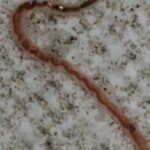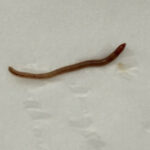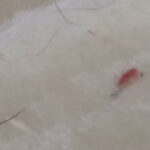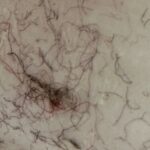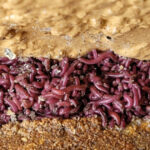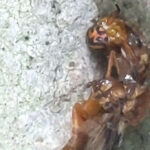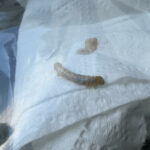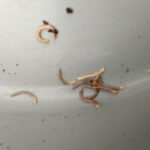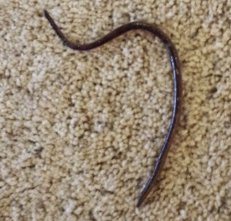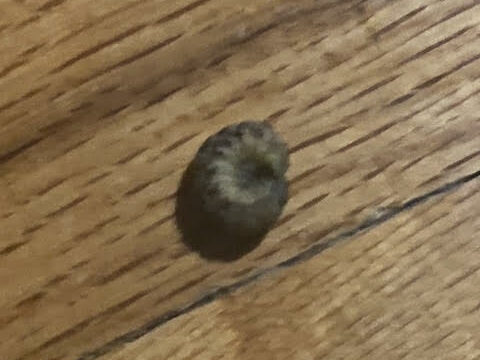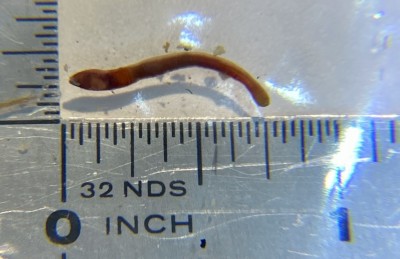
Red worms were found in the sandbox of this reader’s daughter in the south of Florida; our reader wonders if he needs to be concerned about the worms, or if they are harmless. The worms in question are a bright red color, skinny, and vary in length from below an inch to “3 inches long”.
Before we say anything else, we want to give the spotlight to our reader himself for sending in such excellent photographs (and such diverse ones), as well as providing so much helpful context. It is this which makes the process of identifying worms so much easier and accurate, and for that we are thankful. If any of our other readers wonder about what types of photographs they should send in with their query about the worms they find, this is an excellent model to go by. The lighting is good, the camera is focused, and there are even size comparisons to the worms, as well as actual measurements!
Now, our reader found “a lot” of these worms in the sandbox, which to him “look and move like skinny earthworms.” We would say this is a pretty accurate description, especially considering the photo below, which shows one of the worms stretched out to its full length. The only thing that this worm is missing which would make it an earthworm is a clitellum, which is the band of thicker skin one usually sees wrapping around an earthworm’s middle. “When active, they [the worms] stretch out to about 3 inches long. Placed in alcohol, they shrink up to less than an inch.” This is quite interesting, and tells us a lot about what kind of worms these might be, and our reader actually guessed the correct answer, bloodworms. Of course, ‘blood worms’ is merely an umbrella term for various worm and larva species that produce excess hemoglobin (the protein in our blood that carries oxygen), thus turning their skin red and enabling them to survive in low-oxygen conditions. We need to be more specific. These worms look particularly like midge fly larvae.
Midge fly larvae are sometimes referred to as blind mosquito larvae or non-biting midge larvae. This is because the adult fly somewhat resembles a mosquito, but does not suck the blood from mammals as mosquitos do. However, we must say that the latter nickname is somewhat misleading, as the larvae of the midge fly do indeed bite, unlike their adult form, and it is said to be a rather nasty one at that. This may not be true for all species (as there are a recorded 1000+ species in North America alone), but it is better to be safe than sorry. That being said, midge fly larvae are not known to carry parasites or pathogens, and are not parasitic or harmful in any way themselves, so our reader needs not worry for his daughter in that regard.
What puzzled us about these worms, and what had us questioning whether or not they really are midge fly larvae, is the location in which they were found. Midge fly species which are red (thus considered bloodworms) are almost always aquatic species, or at least prefer very damp environments where they feed on decomposing organic matter and/or sediment. That is why midge fly larvae have been found in toilets on various accounts. So, why is it that midge fly larvae are present in a sandbox? Sand is just about the driest environment one could think of. Well, according to our reader the sand in the sandbox “stays pretty wet”, and not only that, but while it has a cover to keep animals from invading (see image below), it cannot keep tiny worms from entering.
The wet sand, likely coupled with plenty of organic matter (sticks, leaves, etc), makes for a decent, albeit unorthodox, home for the midge fly larvae. Despite it being a strange circumstance, these organisms being midge fly larvae makes its own, odd sort of sense. Midge fly larvae are most commonly used as fish bait, and have been known to wash ashore on beaches and dig their way up from the sand, demonstrating that this is a capability they possess. Likewise, their tendency to shrink to smaller sizes given some sort of stimulant (in this case, alcohol) might tell us about the process used to similarly shrink midge fly larvae to be packed in the dense squares of food bait (or fish food!) you get when you buy them.
How the midge flies got to the sandbox is a mystery. Perhaps some fisherman spilled his can of worms, and they all crawled to the nearest damp environment, the sandbox. Maybe an adult midge fly laid her eggs in the sandbox as it was damp and sheltered? Either way, we think that if our reader got rid of these worms, they would not come back, as this environment is too strange for midge fly larvae to end up there on purpose. To get rid of them, we recommend sifting through all the sand and manually removing the worms. The process will be long, but is the only viable option that is safe for our reader and his daughter. Make sure to wear gardening gloves or some kind of protective gear to avoid being bitten!
In order to prevent any kind of creature or bacteria from making this sandbox their home, our reader needs to make sure he keeps his sand dry. To do this, our reader will want to make sure that the sandbox dries in direct sunlight (if wet) before the cover is put back on. Our reader might also want to consider getting a tarp, as the current cover will not keep out rain. Wet sand can harbor not only organisms such as the midge fly larva, but also harmful bacteria. Further to this, raking one’s sandbox and cleaning out any organic debris is vital to keeping out organisms that feed on such things, of which there are many species, such as millipedes, earthworms and, of course, midge fly larvae.
To conclude the red worm-like creatures our reader found in his daughter’s sandbox are midge fly larvae. These bloodworms are not as dangerous as their name suggests, but they can pack quite the punch with their bite, and are nonetheless not welcome guests in a child’s play area. We are confident that if our reader takes steps to get rid of the larvae, as well as adopts the aforementioned preventative measures and makes them a habit, then his daughter will have a bug-free, dry and fun sandbox to play in. The best of luck to our reader and his family!
All About Worms is always free, always reader-supported. Your tips via CashApp, Venmo, or Paypal are appreciated! Receipts will come from ISIPP Publishing.
You might also find these guys interesting!










